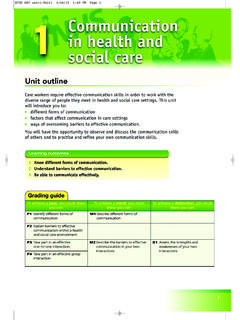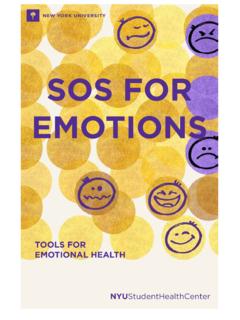Transcription of 1 Introduction to communication in health, social …
1 2 CHAPTER 13232 ACWhat you need to the different reasons people communicate how effective communication affects all aspects of your why it is important to observe an individual s reactions when communicating with themAssessment of this unitThis unit introduces you to the central importance of communication in health and social care work. It focuses on the reasons why people communicate in health or social care settings, the methods they use and the importance of ensuring that communication in care settings is effective.
2 You will need to: understand why communication is important in the work setting be able to meet the communication and language needs, wishes and preferences of individuals be able to reduce barriers to communication be able to apply principles and practices relating to confidentiality at assessment of this unit is partly knowledge-based (things you need to know about) and partly competence-based (things you need to do in the real work environment). To successfully complete this unit, you will need to produce evidence of both your knowledge and your competence.
3 The charts opposite outline what you need to know and do to meet each of the assessment criteria for the unit. Your tutor or assessor will help you to prepare for your assessment and the tasks suggested in the chapter that follows will help you to create the evidence that you you need to how to find out an individual s communication and language needs, wishes and communication methods that meet an individual s communication needs, wishes and how and when to seek advice about different barriers to effective ways to reduce barriers to effective ways to check that that communication has been sources of information and support or services to enable more effective the term confidentiality confidentiality in day-to-day communication in line with agreed ways of situations where information normally considered to be confidential may need to be passed how and when to seek advice about confidentialityIntroduction to
4 communication in health , social care or children s and young people s settings (SHC 21)1 Assessment criteria , , , , and must be assessed in a real work TO communication IN health , social care OR CHILDREN S AND YOUNG PEOPLE S SETTINGS5 Introduction TO communication IN health , social care OR CHILDREN S AND YOUNG PEOPLE S SETTINGSCHAPTER 1 (SHC 21)People who work in health and social care settings may communicate with the people they are caring for, with relatives and visitors, with colleagues and with practitioners from other care agencies, and for a variety of different why communication is important in the work settingWhat is communication ?
5 People who work in health and social care settings need to develop effective communication skills in order to make and maintain relationships. health and social care practitioners communicate with adults for a number of different reasons. This unit will help you appreciate the importance of this aspect of your own work. You must understand: what communication involves the different reasons for communication the way communication affects how practitioners is about making contact with others and being understood.
6 When communicating, people send and receive messages . We all communicate continuously by sending messages. Figure describes how this happens through a communication cycle. The communication cycle is a way of showing that communication involves a two-way process of sending and receiving messages. These messages can be: verbal, using spoken or written words non-verbal, using body language such as gestures, eye-contact and termsNon-verbal: ways of communicating without using words (for example, through body language)Verbal.
7 Forms of communication that use (spoken or written) words Your assessment Identify different reasons why people communicateEffective communication is needed to motivate people and build relationships in health and social care settingsThink about a recent conversation that you had with a service user or colleague. Can you see how it followed the communication cycle?ReflectWhy do you think communication is an important part of care practice? Share some ideas with your work or class colleagues, noting the different ways people communicate in their work study Charlie is 32 years of age.
8 He has very limited speech due to a brain injury he sustained in a motorcycle accident. He now lives in supported accommodation. Charlie enjoys helping out in the kitchen when Clare, his support worker, is making a meal. When she says Can I get some fruit for you, Charlie? , he puts his thumb up, makes a noise in the back of his throat and smiles at her. Clare responds by passing him a bowl of fruit, saying Okay, help yourself this time, Charlie .1. How does Charlie s support worker communicate with him in this example?
9 2. How does Charlie communicate non-verbally with Clare in response to her question? 3. Describe how a cycle of communication occurs in this example. Figure The communication cycle125436 IdeaoccursMessagecodedMessagedecodedMess agesentMessagereceivedMessageunderstood6 Introduction TO communication IN health , social care OR CHILDREN S AND YOUNG PEOPLE S SETTINGS7 Introduction TO communication IN health , social care OR CHILDREN S AND YOUNG PEOPLE S SETTINGSCHAPTER 1 (SHC 21)Understanding why communication is important in the work settingWhy do people communicate in work settings?
10 A lot of communication happens in health and social care settings: many different kinds of conversations occur, as well as a variety of meetings, activity and treatment sessions and consultations with medical and other practitioners that also involve communication . A closer look at these activities will show you that service users, practitioners and other adults interact and communicate with each other for a variety of different reasons in your workplace (see Figure ).Making relationshipsPeople communicate to make new relationships.















